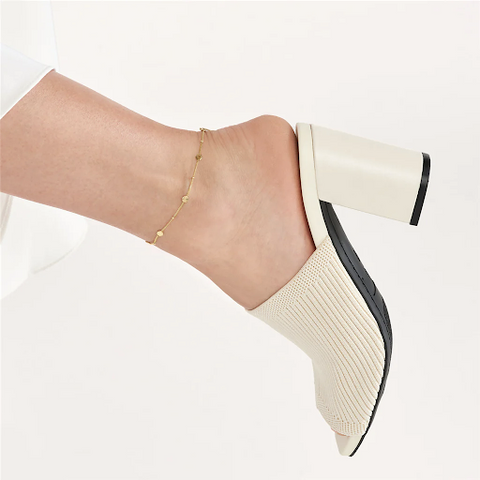
Jewelry has long been a medium of self-expression, much like art and fashion. Ankle bracelets, also known as anklets, embody this principle beautifully. These delicate adornments can enhance an ensemble or convey personal significance. However, the question remains: which ankle should an ankle bracelet be worn on? The answer is more nuanced than simple preference or fashion. This guide will explore the rich tapestry of meanings and etiquette woven around anklets, urging a shift in perspective while satisfying innate curiosity.
The cultural and historical significance of wearing anklets cannot be overstated. In various cultures, anklets symbolize marital status, wealth, or even mysticism. For instance, in the Middle East and India, the wearing of anklets is often associated with femininity and beauty, where they serve as symbols of grace. As such, knowing the cultural context becomes imperative when determining which ankle to adorn with an anklet.
Traditionally, the left ankle is associated with femininity, whereas the right represents masculinity. Thus, wearing an ankle bracelet on the left ankle may connote a more subtle, feminine allure, while the right may signify a bold, masculine statement. Yet, this dichotomy can vary widely across different cultures and social contexts. In Western cultures, for instance, it is becoming increasingly common to wear anklets on either ankle without significant implication.
Understanding jewelry etiquette begins with examining personal intention. Is the anklet merely a fashionable accessory, or does it bear deeper meaning? If the anklet symbolizes commitment or an existing bond—such as a gift from a significant other—wearing it on the left ankle could imply a softer connotation of love and affection. Conversely, if the anklet is a declaration of independence or a statement of personal style, the right ankle could serve as an audacious proclamation of self-assertion and empowerment.
Furthermore, the significance of an ankle bracelet can also be influenced by the type of anklet. Chain-style anklets may carry different connotations than beaded or threaded designs. A delicate chain could suggest elegance and subtlety, often better suited for formal occasions. In contrast, a more robust beaded anklet may evoke a carefree, bohemian spirit, easily complementing casual attire. Understanding these subtleties can add layers to one’s choice of which ankle to adorn.
Fashion trends also play a critical role in this discourse. In recent years, the resurgence of anklets in mainstream fashion has led to a blurring of lines. Tolerance and acceptance of wearing anklets on both ankles have increased. This evolving fashion ethos invites individual expression, allowing wearers to choose based on personal preference rather than adhering to rigid standards. As fashion trends become more inclusive, the previously delineated meanings surrounding left or right may evolve yet again.
Moreover, social settings and occasions also dictate ankle bracelet choices. A formal event may necessitate a delicate, understated anklet on the left, while an outdoor festival could warrant a more playful, colorful ornament on the right. Navigating these social landscapes requires an understanding of the synergy between attire and jewelry, allowing one to communicate both aesthetic and values effectively.
A fascinating layer to consider is the psychological aspect of jewelry wearing. Psychologist Professor Vanessa Brown argues that jewelry has the power to evoke feelings of confidence and self-worth. The choice of which ankle to wear an anklet on may also stem from the wearer’s subconscious expressions; for example, prominently displaying an anklet on the right could be a silent marker of empowerment. This advocacy for fearless personal identity aligns crudely with universal psychology, lingering on the psychological implications of adornment.
It is also essential to consider the intersection of sexual orientation and identity in the discourse of which ankle should bear an anklet. For individuals within the LGBTQ+ community, the anklet can serve as a subtle signifier. Traditionally, an anklet worn on the left ankle may signify heterosexual interest, whereas the right could signal openness to same-sex attraction. However, these interpretations are continually evolving and very much influenced by contemporary cultural shifts aimed at dismantling rigid binaries.
When worn as a style statement, anklets can amalgamate various influences—tone, material, and design. The trend of layering anklets on both ankles provides another avenue for creativity. Wearers can mix metals, styles, and textures, leading to a delightful visual tapestry. Regardless of which ankle dominates the statement, the layered approach creates a profound conversation piece, allowing the wearer’s personality to shine through.
In conclusion, the question of which ankle to wear an anklet on transcends the mere act of adornment. It embodies a complex interplay of cultural meaning, personal expression, and evolving fashion paradigms. As the boundaries around jewelry etiquette expand, so does the opportunity for individuality and creativity. Choosing an ankle for one’s anklet is far more than a mere decision; it becomes an invitation to engage with cultural history, societal norms, and personal identity. Wearing an anklet, regardless of the ankle, serves as an intimate testament to one’s journey toward self-realization and expression.
